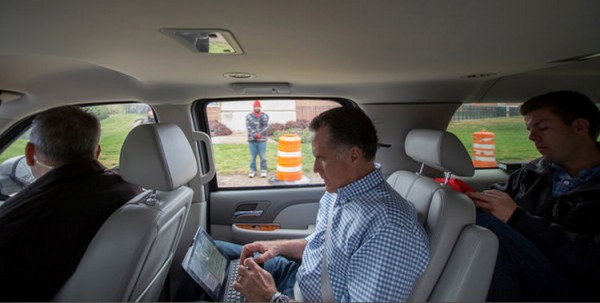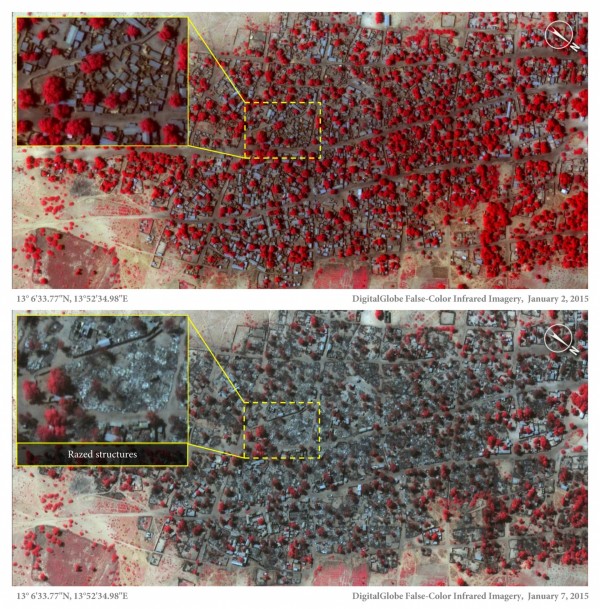We use cookies to help better serve your experience. Accept Cookies
Salon
The Lens in the Mirror: How Surveillance is Pictured in the Media and Public Culture — A Joint Open Society-BagNews Salon
This is the replay of a joint Open Society Foundation/BagNews Salon examining the visual representation of surveillance in traditional and social media.
By Teresa MahoneyHeld Sunday, March 1st, 2015 in coordination with Open Society’s current “Watching You, Watching Me” exhibition, this online HangOut was led by BagNewsSalon moderator and visual scholar, Cara Finnegan of the University of Illinois, and co-produced by curator and writer, Marvin Heiferman.
You can also see the imagery in the slideshow below. The photos for the edit, selected out of thousands, were also crowdsourced from subject experts as well as students from journalism and visual communications programs around the country.
You can use this url to link to the post: http://bit.ly/SurveilInMedia
The BagNewsSalon is an on-line, real-time discussion between photojournalists, visual academics and other visual or subject experts. Each salon examines a set of images relevant to the visual stories of the day often focusing on how the media and social media has framed the event. The photo edit is the key element and driver of each Salon discussion and great care is taken to create a group of 9 photos that captures the depth and breadth of media representation.
Highlight Clips

The visual representation of surveillance in stock photos
Surveillance technology permeates the social landscape. Tiny cameras monitor traffic, parking lots, cash registers and every corner of federal buildings. Through personal devices and social media, citizens also monitor one other. On March 1, 2015, the BagNews Salon, teaming with the Open Society Foundation, analyzed and discussed this phenomena in an online discussion, "The Lens in the Mirror: How Surveillance is Pictured in the Media and Public Culture.” In this highlight clip, moderator Cara Finnegan and panelists Simon Menner, Simone Browne, Hamid Khan, Rachel Hall and Pete Brook discuss generic imagery and the use of stock photography to represent this reality of daily life.
Watch NowPhoto: Felix Clay, Graeme Robertson/Getty Images
Caption: Intelligence agencies and their allies may be hoovering up data on a massive scale. (via The Guardian, January 26, 2015)

Drone surveillance and warfare
Drone surveillance is used by military forces to identify target locations. The images are recorded and analyzed remotely where pilots of these unmanned aerial vehicles can strike into an otherwise impenetrable conflict zone. On March 1, 2015, the BagNews Salon, teaming with the Open Society Foundation, presented an online discussion examining how the world of surveillance is being reflected and mirrored back to us. "The Lens in the Mirror: How Surveillance is Pictured in the Media and Public Culture” is available with full replay and highlight videos here. In this highlight clip, moderator Cara Finnegan and panelists Simon Menner, Hamid Khan, Marvin Heiferman, and Rachel Hall discuss how this image, made by The Reaper, a “hunter-killer” device, presents its own visual vocabulary of site, situation and lethality, a scene and a language that has become all-too-familiar to the public and media consumers.
Watch NowPhoto: Ethan Miller/Getty Images.
Caption: CREECH AIR FORCE BASE, NV – AUGUST 08: A pilot’s heads up display in a ground control station shows a truck from the view of a camera on an MQ-9 Reaper during a training mission August 8, 2007 at Creech Air Force Base in Indian Springs, Nevada. The Reaper is the Air Force’s first ‘hunter-killer’ unmanned aerial vehicle (UAV) and is designed to engage time-sensitive targets on the battlefield as well as provide intelligence and surveillance. (via Imaginary Witness)

"Wedding" from "Blue Sky Days"
Photographer Tomas van Houtryve used a drone camera to juxtapose innocent moments on American soil with captions referencing parallel scenes and situations involving militaristic actions or operations abroad. “Wedding”, an image from the project, “Blue Sky Days,” references the more insidious side of military surveillance and, particularly, notorious western military strikes that have taken place in Pakistan. On March 1, 2015, the BagNews Salon, teaming with the Open Society Foundation, presented an online discussion examining how the world of surveillance is being reflected and mirrored back to us. "The Lens in the Mirror: How Surveillance is Pictured in the Media and Public Culture” is available with full replay and highlight videos here. In this highlight clip, moderator Cara Finnegan and panelists Pete Brook, Marvin Heiferman, and Rachel Hall discuss the political and cross-cultural implications of van Houtryve’s image, and how surveillance and drone imagery has become a new form of aerial photography.
Watch NowPhoto: Tomas van Houtryve.
Caption: A wedding in Central Philadelphia, Pennsylvania. In December 2013, a U.S. drone reportedly struck a wedding in Radda, in central Yemen, killing 12 people and injuring 14. (via Harpers and “Watching You, Watching Me” Open Society Foundation exhibition)

The National Geospatial Intelligence Agency
Photographer Tomas van Houtryve used a drone camera to juxtapose innocent moments on American soil with captions referencing parallel scenes and situations involving militaristic actions or operations abroad. “Wedding”, an image from the project, “Blue Sky Days,” references the more insidious side of military surveillance and, particularly, notorious western military strikes that have taken place in Pakistan. On March 1, 2015, the BagNews Salon, teaming with the Open Society Foundation, presented an online discussion examining how the world of surveillance is being reflected and mirrored back to us. "The Lens in the Mirror: How Surveillance is Pictured in the Media and Public Culture” is available with full replay and highlight videos here. In this highlight clip, moderator Cara Finnegan and panelists Pete Brook, Marvin Heiferman, and Rachel Hall discuss the political and cross-cultural implications of van Houtryve’s image, and how surveillance and drone imagery has become a new form of aerial photography.
Watch NowPhoto: Trevor Paglen’s
Caption: Image of The National Geospatial Intelligence Agency spotlights a government structure which collects massive amounts of data for covert operations. The photo, shot from above at night, shows the symbolic building aglow from within with well-lit roads that extend beyond the frame.

Surveillance Images from the East German Archives
Presenting images found in the East German State Security Service archives, artist Simon Menner’s project, “Images from the Secret Stasi Archives,” reflects on how photography was used as a tool to train spies, conduct secret home searches, and track people’s movements. In this highlight clip, Menner, moderator Cara Finnegan and panelists Marvin Heiferman and Rachel Hall discuss how this historic surveillance image applies to the themes, issues and visual politics surrounding the surveillance debate today.
Watch NowPhoto: Courtesy Simon Menner/BStU.
Caption: Untitled, 2013. (via “Watching You, Watching Me” Open Society Foundation exhibition )

Surveillance, voyeurism and media opportunism: The Ray Rice - Janay Palmer elevator scene
Whether we're conscious of them or not, surveillance cameras in public and semi-public spaces are consistently recording our movements. Moments thought to be private, such as what occurred between Ray Rice and Janay Palmer in an elevator, was not only recorded, but obtained and distributed widely by TMZ. This particular screen capture has drawn considerable attention to issues of domestic violence and the depiction of women in the media, as well as the role of privacy relative to the rights and agenda of the entertainment press. In this highlight clip, BagNewNotes moderator Cara Finnegan and panelists Rachel Hall, Simon Menner, Marvin Heiferman, Hamid Khan and Simone Browne discuss the media’s sensationalizing of a scene depicting Ms. Palmer's beating.
Watch NowPhoto: screen grab via TMZ Sports.
Caption: Former Ravens running back Ray Rice is seen hitting his then-fiancee in an Atlantic City elevator in February.

Police with Body Cameras
Images of police wearing body cameras are often presented to the public as a form of assurance. The fact that the camera in this photo from Sandy Springs is made by a weapons manufacturer is suggestion enough it’s more complicated, though. In this highlight clip, BagNewNotes moderator Cara Finnegan and panelists Pete Brook and Rachel Hall address the layers of meaning in an image of a neighborhood police officer and his body gear.
Watch NowPhoto: Reporters Newspapers.
Caption: Sandy Springs police Officer Jamal Mayberry is one of nine cops who is testing out the TASER AXON, wearable video camera equipment.

Eye in the Sky
It’s one thing when cameras are used by the state to surveil its citizens. It’s another thing when cameras are used by citizens to spy on each other. In this short highlight clip, panelist Marvin Heiferman speaks to an engagingly ominous photo of a drone.
Watch NowPhoto: Video still by Jason South.
Caption: Sky eye … remote-controlled helicopters are capable of carrying cameras. (via Sydney Morning Herald)
The Full Edit
Take a closer look at some of the images from our larger photo edit.


photo: Felix Clay, Graeme Robertson/Getty Images caption: Intelligence agencies and their allies may be hoovering up data on a massive scale. (via The Guardian, January 26, 2015)


photo: Courtesy Simon Menner/BStU. caption: Untitled, 2013. (via “Watching You, Watching Me” Open Society Foundation exhibition )


photo: Ethan Miller/Getty Images. caption: CREECH AIR FORCE BASE, NV – AUGUST 08: A pilot’s heads up display in a ground control station shows a truck from the view of a camera on an MQ-9 Reaper during a training mission August 8, 2007 at Creech Air Force Base in Indian Springs, Nevada. The Reaper is the Air Force’s first ‘hunter-killer’ unmanned aerial vehicle (UAV) and is designed to engage time-sensitive targets on the battlefield as well as provide intelligence and surveillance. (via Imaginary Witness)


photo: Tomas van Houtryve. caption: A wedding in Central Philadelphia, Pennsylvania. In December 2013, a U.S. drone reportedly struck a wedding in Radda, in central Yemen, killing 12 people and injuring 14. (via Harpers and “Watching You, Watching Me” Open Society Foundation exhibition)


photo: Trevor Paglen. caption: NATIONAL GEOSPATIAL-INTELLIGENCE AGENCY (NGA) The NGA is responsible for collecting, analyzing and distributing intelligence derived from maps and imagery. According to documents provided by Edward Snowden, the NGA’s budget request was $4.9 billion last year – more than double its funding a decade ago. It is headquartered in Springfield, Virginia. (via The Intercept)


photo: Broomberg and Chanarin. caption: Yekaterina Samutsevich of Pussy Riot, from Two Eyes Above a Nose Above a Mouth, 2013. (via The Guardian)


photo: Reporters Newspapers. caption: Sandy Springs police Officer Jamal Mayberry is one of nine cops who is testing out the TASER AXON, wearable video camera equipment.


photo: Getty Images. caption: Monitors show imagery from security cameras at the Lower Manhattan Security Initiative in New York in 2013. (via The Boston Globe)


photo: screen grab via TMZ Sports. caption: Former Ravens running back Ray Rice is seen hitting his then-fiancee in an Atlantic City elevator in February.


photo: Video still by Jason South. caption: Sky eye … remote-controlled helicopters are capable of carrying cameras. (via Sydney Morning Herald)
Follow us on Instagram (@readingthepictures) and Twitter (@readingthepix), and subscribe to our newsletter.
Topic
A curated collection of pieces related to our most-popular subject matter.
Panelists
Freelance writer and curator
(Salon Moderator) Writer, photography historian, Associate Professor of Communication, University of Illinois
Associate Professor, Communication Studies at Louisiana State University
Writer and curator
Hamid Khan
Co-ordinator, Stop LAPD Spying Coalition
Artist, and member of OSF surveillance exhibition
Publisher, BagNews Notes


Reactions
Comments Powered by Disqus